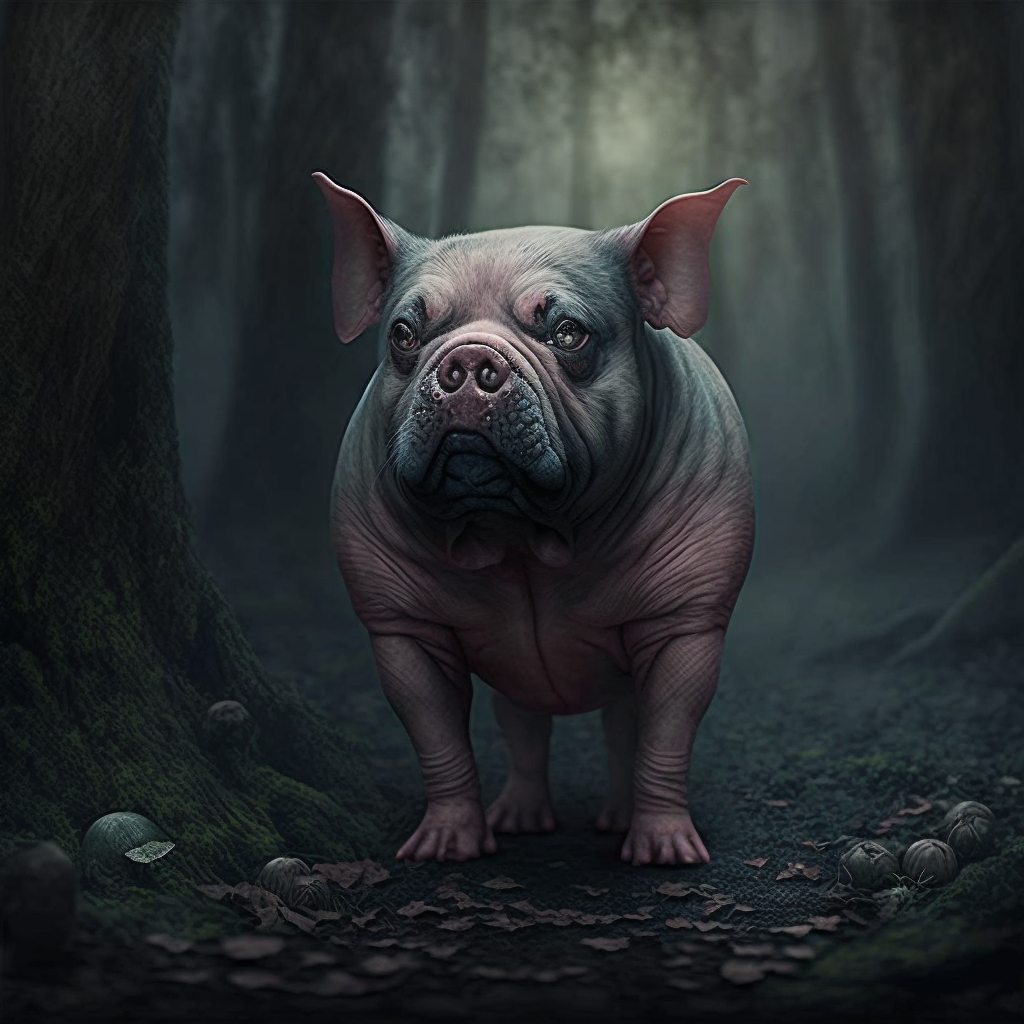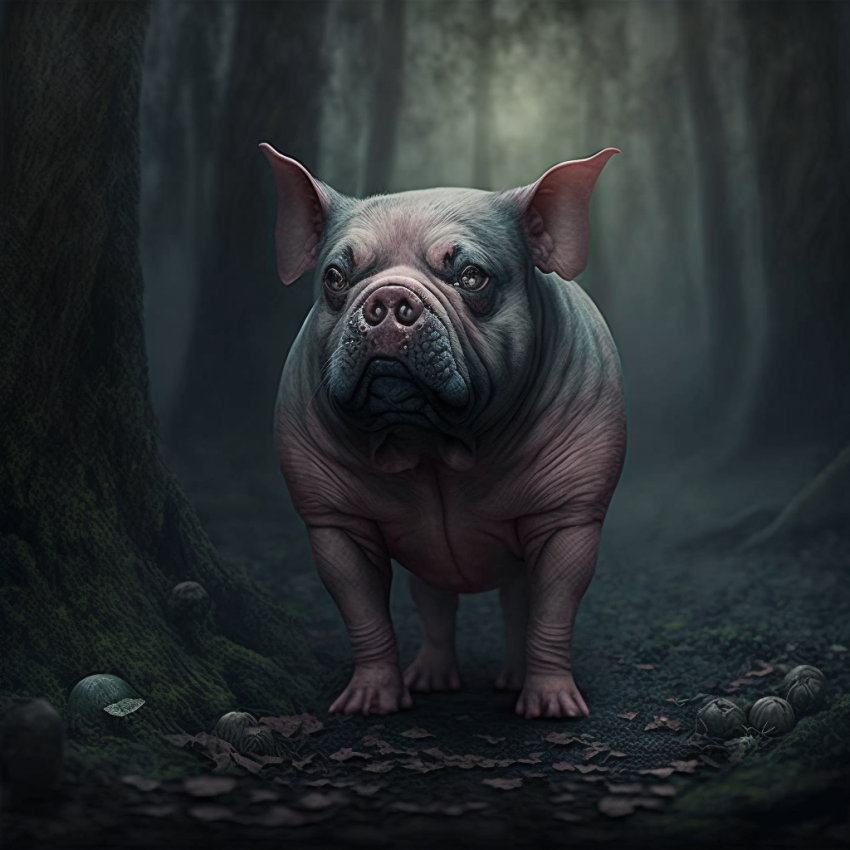
Audio version of this story on our YouTube: https://www.youtube.com/watch?v=x9eVDbiBn30 this can also be found Spotify and most other podcast platforms!
The squonk, or Lacrimacorpus dissolvens, is noted as “Probably the homeliest animal in the world, and knows it” [1]. Much of our information on the squonk comes from two volumes on Appalachian and upper-midwestern lumberlore, Fearsome Creatures of the Lumberwoods, With a Few Desert and Mountain Beasts by William T. Cox [2], and Fearsome Critters by Henry H. Tryon [1]. Taken together, their descriptions and accompanying lithographs paint a picture of a morose dog-pig hybrid, hairless and weeping, and covered with warts and moles. According to Cox, “Because of its misfitting skin, which is covered with warts and moles, it is always unhappy ; in fact it is said, by people who are best able to judge, to be the most morbid of beasts” [2].
This melancholy extends beyond its appearance, and it is said that the poor animal weeps constantly. Tryon notes that “He is given to constant weeping over his really upsetting appearance, and can sometimes be tracked by his tear-stained trail” [1]. Cox corroborates this, noting that hunters are often able to follow the squonk by its tear-stained trail [2], and Tryon notes that these squonk hunts are best performed by moonlight[1]. The squonk is not without its defenses though, as when surprised or frightened, it can dissolve itself into a puddle of tears to escape capture [2].
Records of the squonk mainly come from the hemlock forests of Pennsylvania [1,2]. They make their home in these hemlocks, and are active only during the twilight hours, returning to their hemlocks before moonrise, where they can avoid catching a glimpse of their reflection in a moonlit pool, an event that will often bring the squonk to tears [1]. The ancient distribution of the squonk was thought to be much wider, but as the high plains where it roamed gradually turned into swamps, it was forced to try to adapt to water [1]. Between the squonk’s limited cognitive abilities, and the fact that it only evolved webbing on its left feet, it found itself unable to swim, merely going in circles when it tried to enter the water [1]. It finds its hemlock homes of today much more suitable.
Cox relates an amusing anecdote of an attempt to capture the creature in his book [1]…
Mr. J. P. Wentling, formerly of Pennsylvania, but now at St. Anthony Park, Minnesota, had a disappointing experience with a squonk near Mont Alto. He made a clever capture by mimicking the squonk and inducing it to hop into a sack, in which he was carrying it home, when suddenly the burden lightened and the weeping ceased. Wentling unslung the sack and looked in. There was nothing but tears and bubbles.
This appears to be the first “sighting” of a squonk, and is the one that is generally reprinted in early newspaper articles on the creature, most of which appear after the publication of Cox’s book in a syndicated column that ran on January 27th and 28th, 1912 [3–5]. There was an additional sighting in 1919 of a “red, white, and blue squonk” that attacked a man on his way home in Anderson, IN, though given that the title of the article is “Prohibition Notes”, this could well be a joke about prohibition that has lived on in newspaper archives past its relevant cultural context [6].
There is speculation that the squonk and other fantastic creatures were made up out of whole cloth for books such as Fearsome Creatures of the Lumberwoods and Fearsome Critters, and that these volumes exist as fantasy bestiaries written purely to bring joy to their audience. While this was certainly a goal, it does seem that there was a genuine effort made in these books to preserve the folklore of lumberjacks during a time in the United States when lumberjacks themselves were becoming less common. William T. Cox himself was a forester, who early in his career worked for the United States Forest Service before becoming the State Forester and Commissioner of Conservation in Minnesota. He would have had extensive contact with loggers, and his desire to preserve their imaginative sense of wonder comes across in the introduction to Fearsome Creatures of the Lumberwoods, recounted here in full [2].
Every lumber region has its lore. Thrilling tales of adventure are told in camp wherever the logger has entered the wilderness. The lumber jack is an imaginative being, and a story loses none of its interest as it is carried and repeated from one camp to another. Stories which I know to have originated on the Penobscot and the Kennebec are told, somewhat strengthened and improved, in the redwood camps of Humboldt Bay. Yarns originating among the river drivers of the Ottawa, the St. Croix, and the upper Mississippi are respun to groups of listening loggers on Vancouver Island. But every lumber district has its own peculiar tales. Some have their songs, also, and nearly all have mysterious stories or vague rumors of dreadful beasts with which to regale newcomers and frighten people unfamiliar with the woods. Much has been written concerning the lumber jack and his life; some of his songs also, rough but full of the sentiment of his exciting vocation, have been commemorated, but, so far as I know, very few of the strange creatures of his imagination have ever been described by the naturalist or sketched by the artist.
The lumber regions are contracting. Stretches of forest that once seemed boundless are all but gone, and many a stream is quiet that once ran full of logs and echoed to the song of the river driver. Some say that the old type of logger himself is becoming extinct. It is my purpose in this little book to preserve at least a description and sketch of some of the interesting animals which he has originated.Tryon cites a similar rationale for his work in the preface to Fearsome Critters, noting that he had collected these stories for decades prior to the publication of his book, and noting how it was in the nature of lumberjacks to take a startling encounter with an animal in the forest and spin it into a fantastic yarn of high adventure for their fellows back at the camp [1]. He also claimed that many of the tales of creatures he recorded potentially dated back over a hundred years, though some of his correspondents claimed they were much newer [1]. Regardless, the impression given by both authors was that the tales in these books were related to them by the lumberjacks themselves, rather than invented specifically for the books. While the prefaces could of course themselves be part of the fiction of the books, a contemporary essay by naturalist and folklorist Marjorie Edgar lends credence to the claim that many of these stories were related to the authors by loggers [7]. So maybe, just maybe, somewhere deep in the hemlock woods of Pennsylvania, an adorably ugly little squonk is sitting in its home afraid of its own reflection.
Remember, if you have had a creepy experience, or if you have a paranormal story of your own, send it in to us at webmaster@spookyappalachia.com.
Thank you to our patrons, Alvin, Charles, Danielle, Donald, Jeff, Jordan, Josh, Julia, Linda, Shannon, and Taylor. And thank you for tuning in.
Source(s)
Tryon HH. Fearsome Critters. Cornwall, NY: Idlewild Press; 1939.
2. Cox WT. Fearsome Creatures of the Lumberwoods, With a Few Desert and Mountain Beasts. Washington, DC: Judd & Detweiler, Inc.; 1910.
3. Bache R. Wild Beasts That We Know But Little About. El Paso Herald. 1912; 6.
4. Bache R. Terrible Wild Beasts, New to Science, Found in Remote and Dismal Haunts. New-York Daily Tribune. 1912; 3.
5. Bache R. Ferocious Wild Beasts Almost New to Science. The Washington Herald. 1912; 4.
6. McLuke L. Prohibition Notes. The Alaska Daily Empire. 1919; 4. 7. Edgar M. Imaginary animals of northern Minnesota. Minnesota History. 1940;21: 353–356.

